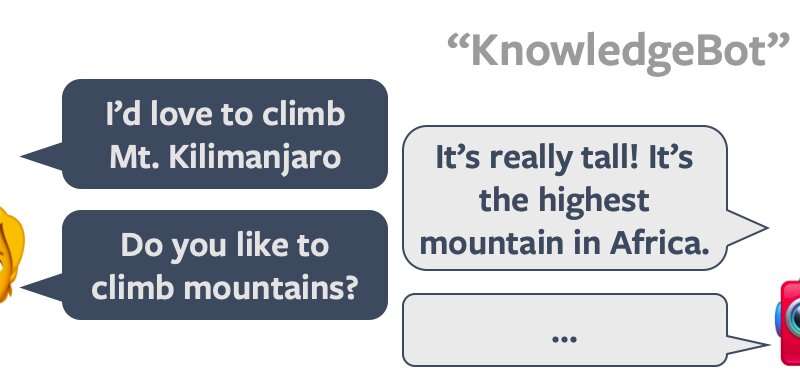Creating chatbots with multiple conversational skills
Source: Ingrid Fadelli
 In recent years, chatbots have become increasingly sophisticated, and they now provide basic assistance to humans on a variety of online platforms, including Facebook and a number of e-commerce sites. So far, chatbots have typically been designed to excel at one individual conversational skill or style, for instance, in providing customer assistance or offering basic information on a given topic.
In recent years, chatbots have become increasingly sophisticated, and they now provide basic assistance to humans on a variety of online platforms, including Facebook and a number of e-commerce sites. So far, chatbots have typically been designed to excel at one individual conversational skill or style, for instance, in providing customer assistance or offering basic information on a given topic.
Researchers at Facebook AI Research have recently carried out a study investigating the possibility of combining the skills of different conversational agents, to enhance their overall capabilities. Their paper, pre-published on arXiv and set to be presented at ACL 2020, proposes different techniques to combine the skills of different models into one, while also introducing a dataset that can be used to analyze how well individual conversational skills trained in isolation would mesh together in a single agent.
"Before this project, our team had produced a few AI models that were each very good at talking to humans in a certain way: we had a model that could incorporate knowledge into the conversation, a model that was good at responding empathetically, and a model that was good at being consistent when talking about talking about its persona," Eric Smith, one of the researchers who carried out the study, told TechXplore. "Our goal in this study was to produce a single model capable of smoothly switching between and blending all three of these kinds of communication."
Human beings are capable of automatically switching to different conversational styles based on the situation in which they find themselves. For instance, a human speaker would be able to alternate between talking about him/herself, listening to others and consoling them, exchanging knowledge or information about something, and so on. Smith and his colleagues wanted to reproduce this ability in conversational agents, creating a single model that would be able to communicate with humans in several different ways.
Credit: Smith et al.
"To start off, we trained a single model on three different sets of conversations, where each set of conversations had a different context and was designed to demonstrate a different skill: talking about oneself, listening with empathy, and providing knowledge," Smith said. "This allowed our model to do well on each of those skill benchmarks in isolation."
Initially, the researchers were not sure about how they could teach their model to switch seamlessly between different conversation skills in a similar way to humans. They thus decided to collect a new dataset, dubbed BlendedSkillTalk, which can now be downloaded on the ParlAI online platform. This dataset includes approximately 5,000 human dialogues in which speakers switch between three conversational styles, namely talking about themselves, empathically reacting to stories shared by others, and sharing knowledge, all within the span of a single conversation.
"One way we did this was by picking one of the two speakers at random for each conversation and giving that speaker three different suggestions about what they could say each time it was their turn to speak," Smith explained. "Each of these three suggestions would show one of the three skills of interest that we wanted the speakers to switch between. The speakers could choose whether they wanted to utilize any of the suggestions or not, but the upshot was that we found that almost all of the participants' conversations showed at least two of these three conversational skills."
When Smith and his colleagues trained their model on the dataset they compiled, they found that its ability to mimic the blended conversations contained within it improved significantly. Moreover, the conversations contained within the BlendedSkillTalk dataset specifically emphasize the blending of multiple conversational skills, which makes it ideal for evaluating a model's performance at juggling different skills.
Credit: Smith et al.
"Our dataset features examples of switching from one conversational skill to another, so it provides a more holistic test setting than evaluating a model on multiple separate single-purpose datasets," Smith said. "Our study shows how to leverage existing datasets that are focused on one skill each in order to train a model that can blend those skills seamlessly in a conversation."
The study carried out by this team of researchers could have a number of interesting implications for the development of conversational agents. Firstly, Smith and his colleagues introduced techniques to blend conversational skills into a single computational model, which could ultimately enable the development of more versatile and better performing chatbots. In addition, the new dataset they compiled could be used by other research teams to train, evaluate and compare other natural language processing models.
"We would now like to extend this work by further increasing the diversity of skills that a single model can be trained to perform well at: for instance humor, commenting on images, conversation to accomplish specific directed tasks, etc.," Smith said.
| }
|